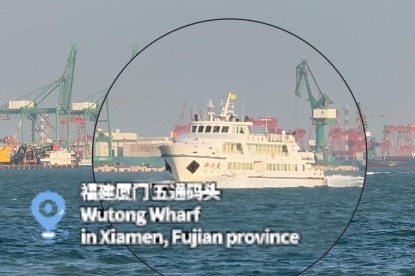Trade dispute an inflammation as relations are recalibrated

As the United States and China lock horns in trade frictions, some worry that if the situation escalates into a self-destructive spiral, the world's two largest economies will have no choice but to sever all their trade ties. China Daily reporter Li Yang comments:
To completely decouple, as some hawks on the US side have proposed, would indeed be the worst-case scenario. But that is unlikely to happen as undoing the connections between the Chinese and US economies could ignite a US debt crisis — over the past five years, the nominal growth of its gross domestic product was 4.3 percent, and its debt rose 4.7 percent.
To reduce its trade deficits is only a pretense providing Washington with a convenient excuse to press Beijing to swallow a basket of radical reforms in line with US interests. The US administration's strategic objective is to tame its foremost challenger, whose unique development path and political system make its rise a thorn in the US' side.
In fact, the Barack Obama administration's Trans-Pacific Partnership proposal can be seen as a trial to explore the possibility of partially unhooking the US connections with China, though in a mild manner compared to the current US administration's efforts to achieve some decoupling.
When Japan's GDP neared two-thirds of that of the US in the 1980s, as China's has today, the US successfully stifled Japan's rise and ended the possibility of it being a substantial challenger. Washington is just pouring old wine in a new bottle in its dealings with Beijing.
The US' stop-at-nothing approach toward China's high-tech companies, and its politicians' unsparing efforts to prevent other countries from cooperating with China and Chinese companies, lays bare Washington's anxiety about the possibility of losing in the competition with China.
For decades, the US has encouraged China to buy its national bonds with the trade surplus — to secure China as a piece in its economic jigsaw puzzle so that the US people can continue to live on borrowing and cheap commodities — and prohibited it spending the money purchasing high-tech products from the US as well as other Western countries.
The balance would unavoidably come to an end as it is now when China's production factors become expensive, forcing it to drive growth through innovation and consumption. In other words, while China is elbowing into the club of developed economies, the US suddenly realized no country can replace China's role in helping to sustain US prosperity.
The trade dispute is only an inflammation caused by the inertia of the US and the accumulation of a series of changes in China.
Talks on an equal footing represent the only rational way for the two sides to recalibrate their relations and address each other's core concerns. If the two countries fail to take the opportunity to rebalance their economic ties, which entails structural reforms on both sides — the US needs to reduce its consumption and divert more attention to the real economy while China should deepen its market reform and improve its business environment — neither side will be left unscathed.


































